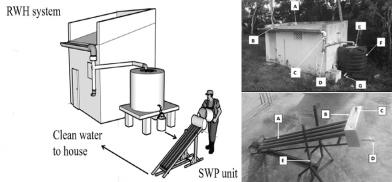Low-cost drinking water technology for rural areas
Both the quantity and quality of drinking water in India, especially in rural areas, leaves much to be desired

Both the quantity and quality of drinking water in India, especially in rural areas, leaves much to be desired. More than 66 percent of India’s population stays in rural areas and 85 percent of this rural population uses groundwater for drinking purposes. With an estimated groundwater usage of 230 km per year its availability is endangered due to the lowering of groundwater table and saline water intrusion in it in many parts of India. Besides in many areas the presence of fluoride, nitrate, iron, and arsenic in the groundwater also constitute a health hazard. Presently purification of drinking water is carried out by various types of filters which are uneconomical and often use electricity which is unavailable in rural areas. Also, chlorination which is used extensively to remove coliforms can have health-associated risks.
A very simple and low-cost drinking water technology (DWT) based on efficient rainwater harvesting and solar purification has been developed by the Nimbkar Agricultural Research Institute (NARI), Phaltan in district Satara of Maharashtra state. DWT uses no electricity and harmful chemicals. A detailed paper on this DWT was recently published in Current Science.
Rainwater harvesting
Basically DWT consists of; (a) rooftop rainwater harvesting (RWH) (b) cleaning of rainwater of its debris and suspended material. (c) removing microbiological contaminants via solar heating.
Rainwater catchment is via roof flowing into a syntax tank. As per the building norms, the minimum habitable area required for a family of five is 9.5 square metres. At NARI an RWH system for a single room dwelling having 12 square metres roof area and corrugated GI as roof material was installed. Phaltan is situated east of the Sahyadri range in Western Maharashtra and is in the rain shadow zone. It receives around 500 mm of annual rainfall concentrated in about 3-4 months of the year. The 12 square metres roof area selected was deemed sufficient to meet the annual drinking water demand of a typical family of five with daily drinking water consumption of 10-15 liters.
The rainwater falling over the roof was collected with the help of semi-circular PVC pipes which are readily available in the market. The size of these collection channels was determined based on the maximum rainfall intensity at Phaltan. A readily available 3000 liters PVC storage tank was used based on rainfall distribution at Phaltan. More than 80 percent of water collection efficiency was easily achieved by designing the RWH system based on the amount and intensity of rainfall and the size of the roof and collection channels. A coarse stainless steel mesh was used to prevent the entry of leaves and other debris in the down tube going into the tank. At the same time, cloth filter at the tank entrance helped to prevent mosquito breeding in it.
Unlike groundwater, rainwater is free of salts and other harmful chemicals like arsenic. However, it can get contaminated with windblown dust, animal droppings, leaves, and decayed organic matter on the roof. These cause the collected water to become brownish in colour. Removal of this colour was effectively and economically done by alum (20 mg/litre water) which coagulated the contaminants in slurry and made it settle down. Alum also partially inactivates the coliform bacteria.
Microbiological testing of collected rainwater at NARI by the most probable number (MPN) technique gave an average coliform count of 1600. Thus the collected rainwater is not fit for drinking and it has to be purified to remove the coliforms. This was done by using a very simple and unique solar water purifier that does not use electricity.
Solar Water Purifier
Solar Water Purifier (SWP) developed by NARI is a non-polluting, user-friendly system that makes the water potable by heating it using solar energy. SWP has a capacity of 15 liters and consists of four tubular collectors attached to a manifold. Even on a completely cloudy day, the stagnant temperature of the water in them reaches 450C for more than three hours which is adequate to inactivate all the coliforms. Tests done on DWT for last one-and-half-years years have shown that SWP cleans the water 98 percent of the time. Only for 6-7 days in a year, the temperature in SWP is not sufficient enough to remove coliform.
Normally rainwater harvesting is done to use it as greywater mainly for industrial uses, gardening, and cleaning. DWT suggested by NARI offers a simple and low-cost solution to use rainwater for potable purposes.
Rural schools are felt to be the most appropriate platform for the initial testing of DWT and NARI has taken up a Bajaj-CSR funded project to put a few DWT systems on trial basis in rural schools near Phaltan. Besides providing clean drinking water to school children this will also expose them to solar energy knowledge.
The costliest item in the proposed DWT is the storage tank and it accounts for more than 70 percent of the cost of the RWH system. RWH can become economical to the rural poor only if some form of financial assistance is available for purchasing the storage tank. ‘Water for All’ is the flagship programme of the Government of India to provide water in rural areas. It is estimated that annually Rs. 5000 to 10,000 crores are spent on this programme with very little to show on the ground.
It is felt that helping rural households to install the RWH system will be more effective use of these funds. A direct bank transfer by government of India can be used for this purpose.
(The writer is Director, Nimbkar Agricultural Research Institute (NARI), Phaltan, Maharashtra. He can be contacted at anilrajvanshi@gmail.com. Nandini Nimbkar is President, NARI)










Post a Comment